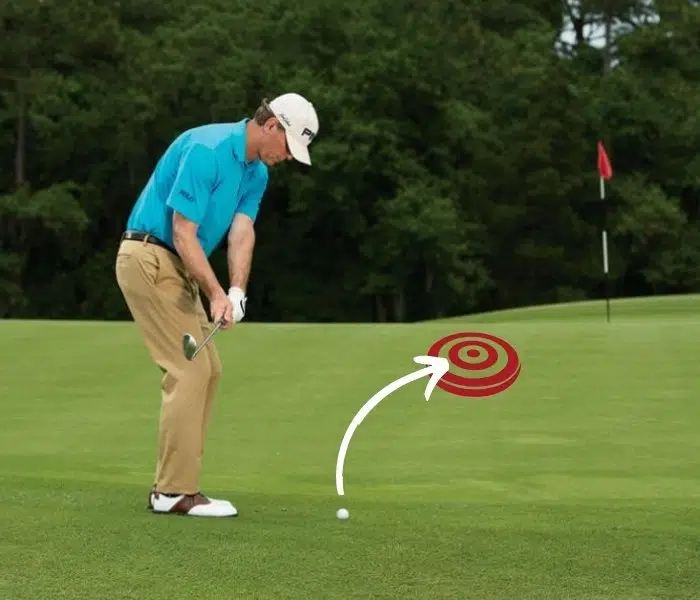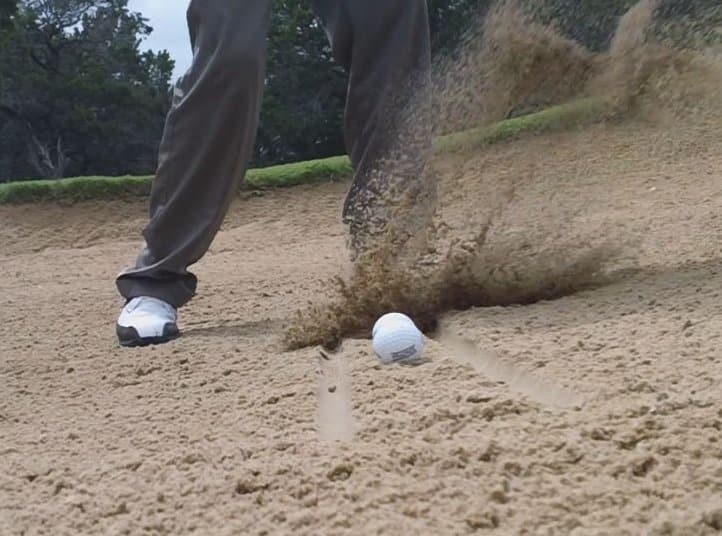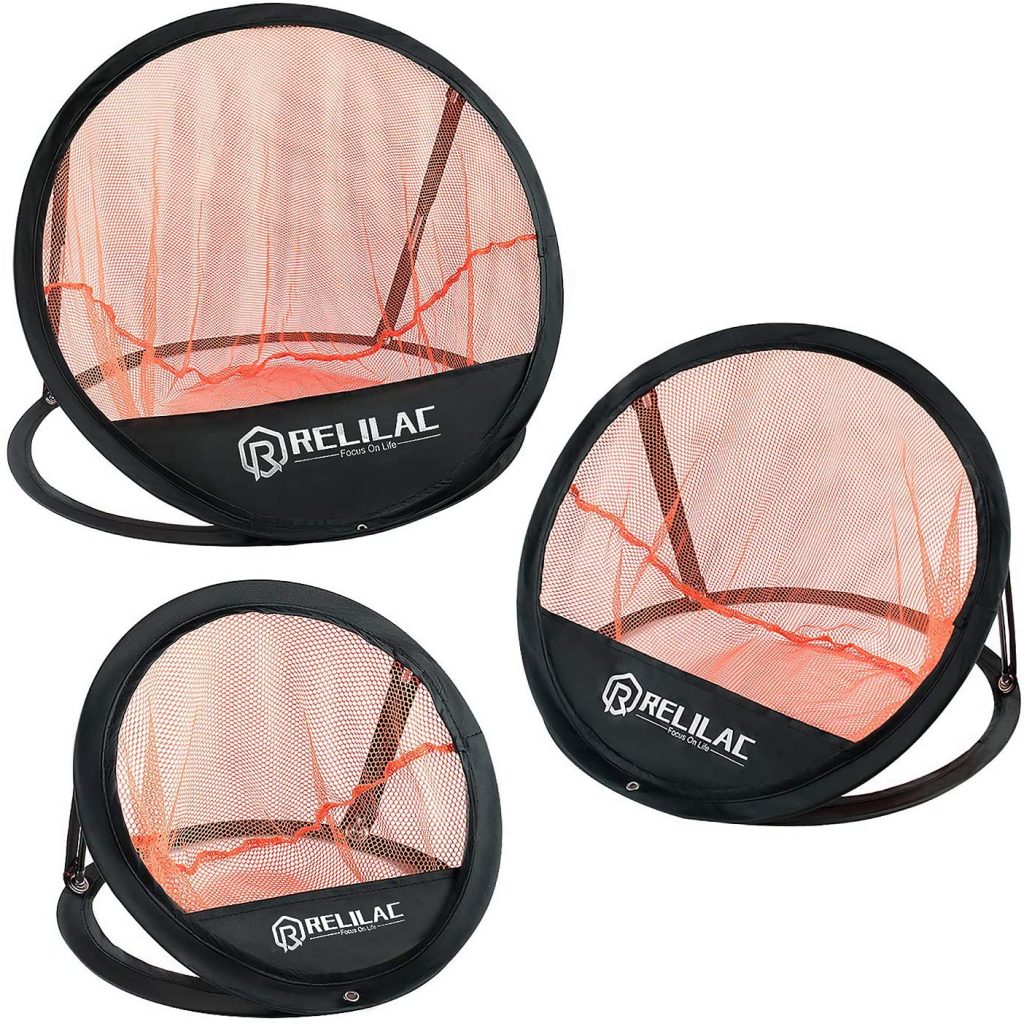While many golfers strive to break 100 – and then 90 soon after – when it comes to breaking 80, well, that’s a barrier that the vast majority of golfers will never cross.
There’s no doubt that each stroke becomes exponentially harder to shave off as your scores get lower, so sneaking a score in the 70s feels like an absolute grind for many golfers.
To break 80 in golf, you need to generate more distance off the tee, nail your recovery game and get up and down regularly. Mastering ball flight control will get you nearer to the green from tough situations, and turning these into up and downs will create pars from scenarios that were once bogeys or worse. This will reduce blow-out holes, something you have to do to crack 80.
As with breaking every scoring barrier, there are a number of things you can do to set yourself up for success, and these tips and strategies below are what I used to take my game from hovering around the 90s to shooting below 80.
If you aren’t quite at this stage then explore our guides on breaking 100 and breaking 90 first, otherwise, let’s get stuck into my 16 best strategies to develop a game that will get your scores under 80.
Table of contents
1. Practice twice a week
Whether you like it or not, there’s no avoiding the fact that players who shoot in the 70s practice regularly, and by that I mean at least twice a week.
Now these practice sessions needn’t be 140 ball slug fests down at the range, but you need to hit balls at least once a week at the driving range, hitting everything from driver down to wedges.
A second practice session could be around chipping in the back yard, hitting off of an artificial turf mat and trying to make clean contact and hit your spot using a chipping net.
If you live a decent distance from the range or course, arrive an hour early for your weekend round and have a solid short game/putting session before you play.
You can still break 80 without this pair of practice sessions a week, but it will be a flash in the pan, rather than a habit that will see your handicap slip down into single figures.
2. Find more distance off of the tee
For all the videos out there on course management and working your way through each round avoiding trouble, there’s no doubt that strokes gained data mounts a legitimate case for getting the ball down there as far as you can.
While there’s definitely a time and place on every course for a 4-iron off of the tee, when there is low to medium risk and a long tee ball into wedge range will help you hunt for birdie, you really need that big stick to be a weapon.
Using a tool like the lag shot to develop lag through practice will help load the club with extra power, helping increase ball speed.
The super speed system can also help you up your swing speed, but raw speed doesn’t necessarily translate to ball speed unless your swing is efficient.
A transition to a more inside path is something that really helped me gain extra distance given my original over the top swing, so practicing with a training aid that will redirect your path will help to ensure your speed is actually transferred into the ball for more distance.
If you hit the ball quite high, then maybe a lower lofted driver or stiffer shaft can help lower your flight and get the ball out there further too.
Regardless of all the gear out there to help you improve your driver game, anxiety around hitting the big dog can be deeply embedded for some people, and if you go it alone you might just find wayward drives send your scores in the wrong direction.
A few lessons with a teaching pro will help to diagnose your issues and set you on a path to hitting the ball further off the tee.
3. Miss in the right places
I understand this may sound a little contradictory given I just implored people to embrace a more strokes gained attitude, but you obviously need to pick your moments and ensure that, when there is adequate risk involved, you make decisions that might not always be distance based.
This applies to approach shots, as well as tee shots, as the best golfers who break 80 often will always play for best miss rather than the perfect shot.
If you play at a course with water, tight OB or numerous hazards, it only takes two or three wayward shots to really ruin a crack at a sub 80 round, unless you run hot with the putter and string a few birdies together.
You should always use a rangefinder to zap hazards and danger or consider buying a Garmin golf watch so you always have a full picture of how far you have to anything that could ruin a hole.
The Garmin Approach range are some of the best golf watches out there, but I personally use and love a Garmin Vivoactive 4, ideal for someone after an all-round option.
This way, you can club up to ensure you carry pots or club down to lay up short of water, and accepting a safe par is better than an attempted birdie that becomes a blow up hole with one poor swing will have a huge impact on your ability to go low.
You need to work through your round trying to place your tee shots on the side of the fairway that will give you the best angle of attack, and don’t be afraid to aim well away from tucked pins, even to the point where you might miss the green.
Given you should be practicing your short game regularly if on the journey to breaking 80, the prospect of more frequent up and downs means there’s less pressure on you hitting it close anyway, and by doing so you’ll stay away from bunkers and hazards.

4. Get up and down regularly
When trying to break 80 there’s no doubt you need to be able to get up and down, not only to save some pars but to avoid bad holes becoming really bad ones.
Double bogies are the absolute killer when trying to break 80, so having enough confidence in your short game to know that an up and down could still scrape a bogey on a hole where you sliced it left and had to pitch out will relieve pressure on the longer part of your game.
If you do only one thing to improve your chipping, it needs to be practicing your ability to hit a spot time and time again.
If you can move through 8-iron to 60-degree wedge and hit the same spot 7 or 8 times out of 10, then you’ll be able to get the ball inside three feet range from a number of different situations.
Some simple chipping rings are a great tool to practice with, and by mastering a higher chip that stops quickly, as well as the bump and run, you’ll give yourself more makeable putts from easy and tricky short game situations.
5. Get spin out of the bunkers
It’s one of the more challenging things to get right in golf, but if you can develop greenside bunker shots that take a couple of bounces and grip, stopping dead, you’ll drastically increase the regularity with which you get up and down from the sand.
The first step to being able to achieve this comes from the most basic of habits that so many golfers don’t follow: ensuring your clubs are clean.
The grooves are there for a reason – to impart spin on the ball – so never attempt a bunker shot without first cleaning your club face and grooves.
A simple brush that clips to your bag will soon become one of the most used pieces of golf equipment you own.
Additionally, you need to use a high quality golf ball, designed to spin more around greens and perform better than cheaper alternatives.
From here, you should be playing the ball forward in your stance, keeping the club face nice and open.
Speed is absolutely your friend here too, so you need to take a backswing that will give you confidence to swing quickly through the shot, upping the revs you impart on the ball and helping to create spin.
While the technique is straight forward enough, having the confidence in your strike to really accelerate through the ball will only come about from one thing: practice.
Avoid the temptation to pump driver for an hour during your next range session, make your way to the short game area and commit to 20 spinning bunker shots to build the confidence necessary to unleash it on the course.
6. Improve your overall bunker game
Most amateur golfers avoid bunkers like the plague given that it’s often a raffle as to whether they will get out of them or not on the first attempt.
While it is definitely sound advice to try and avoid bunkers altogether, as we all know, no matter how hard you try and do something in golf you are bound to make a few mistakes.
While most golfers can hack a ball out of a greenside bunker and onto the green – albeit not necessarily close – fairway bunker shots are an extremely weak area of many people’s games.
If you can improve this to the point where you can hit greens out of a bunker form 150 yards away, you’ll end up far more confident in making par from wayward drives that find the sand.
Weight shift is the key here, ensuring that you keep a stable head and spine while rotating, rather than swaying.
Avoid the temptation to lift the ball into the air, working the weight into the lead side through contact to strike slightly down on the ball.

7. Learn to hit ‘players irons’
One of the more nerve wracking decisions I made in regards to my golf game was making a switch from traditional cavity back or ‘game improvement’ irons to a players iron, sort of the transition point between cavity backs and blades.
The top line was narrower and as someone on the verge of single figure golf I was sceptical as to whether I was ‘ready’.
However, the golf pro I was working with assured me that my swing was at a point where my chunkier irons where actually hurting my swing, rather than helping it, and thankfully my purchase of a set of Titleist T100 irons has been a magnificent decision.
People who are on the verge of breaking 80 generally have pretty decent swings and have probably come from a position of using beginner clubs that they bought when starting out in the game.
These are great for when you swing slow and miss the middle of the club often, but if you have built a respectable swing, players irons will actually lead to more height, greater workability and increased reward for good strikes.
Rather than feeling like you are navigating your way around the course, the ball flight and options a higher quality players iron will give you can actually lead to some more aggressive shots at accessible pins and get you in one putt range more often.
8. Hole more putts
There’s no doubt the average golfer has a real fear of three putting, contributing to a tendency to put conservatively, leave 15 footers short, then end up with a three putt anyway.
Breaking 80 is made a lot easier by rolling a birdie or two in during your round, so it’s absolutely vital to get the ball to the hole if you want to one putt a few holes each round.
The main reason people struggle to be aggressive with their putts and get them past the hole is the dreaded 3 footer they worry about on the way back, something that may come about through lack of confidence from the wrong putter for your stroke.
If you become an absolute demon inside three feet, then you’ll gain a huge amount of confidence in finishing off, meaning you can really have a crack at some putts in that 10-12 foot range instead of lagging them.
A putting mat for your home is vital if you want to improve both alignment and pace control and is one of the cheapest purchases you can make to improve your game. I personally love any version from Putt Out as the rubber base is super stable on my hardwood floor at home.
The Putt Out Pressure Trainer is also a great way to get pace feedback when knocking balls around on a fairly innocuous putting mat, and I can not recommend these two products enough for helping out your flat stick game.
Green reading is also a contributing factor in determining the right pace, so you need to really commit to a more focused putting routine, rather than getting on your haunches from behind the ball and picking a spot.
Get in the habit of reading the green from multiple angles, observing the cut of the cup and identifying the grain, all things the pros do who, unsurprisingly, hole way more putts than you do.
9. Use more loft around the greens
For the higher handicapper who has nightmares about tight lies and blading balls over the green, the 7-iron bump and run should absolutely be their go to around the greens.
However, if you are on a journey to breaking 80 and in search of more up and downs, then you must become more accustomed to using loft around the green.
The confidence to play higher lofted wedges, like a 56- or 60-degree wedge, is going to come through more consistent contact, and the only way to develop this is through grinding it out in the short game practice area.
I can speak from experience as someone who would always revert back to a bump and run when I shot around 90 most weeks, essentially due to that fear of skulling the ball through the green.
However, when I transitioned to a wedge with lower bounce, a Cleveland Zipcore with 6 degrees of bounce, in fact, I actually felt far more confidence to be able to nip the ball cleanly from tighter lies.
This did require adjustment and the conviction to accelerate through the ball, but feeling good around the greens with a higher lofted club will give you the ability to stop the ball quicker near the whole, setting up more putts from inside three foot after having to go aerial to clear a hazard.
10. Buy a high-quality watch and rangefinder
While its great advice for almost any golfer to go out and purchase a rangefinder, if you really want to take your game to the next level then a high quality purchase might be in order.
If you buy a rangefinder that accounts for elevation, such as the Bushnell V5 Rangefinder, then you’re smartly allowing technology to help you as much as possible, and in golf, we need to take all of the help we can get.
I’d also recommend considering a golf watch to give you distance readings to the front and back of the green, as well as hazards.
If you know the pin is right at the back of the green, play to the front, knowing you have plenty of room to work with if you come up short.
While a rangefinder is obviously great for zapping pins, a watch will give you readings you otherwise wouldn’t be able to obtain.

11. Invest in a launch monitor
This is definitely the most ‘optional’ piece of advice on this list, but what would once have been considered ludicrous is actually quite a reasonable suggestion given the range of cheap, compact launch monitors on the market today.
Over and above, the main drawcard of a launch monitor is the fact that numbers don’t lie, and if you want to break 80 but just can’t shake that annoying hook, a launch monitor doesn’t lie when it repetitively tells you your face was closed at impact, no matter how open it felt.
The issue with breaking 80, as opposed to breaking 90, is that it’s exceptionally hard to grind your way through the course to a score that starts with a seven: there really needs to be some genuine golf shots played, be them a carefully executed draw or a spinning flop shot over a hazard.
If you understand your game and can account for a poor shot shape fairly well, you may well break 90 with regularity, but probably not 80.
This is why genuine feedback from a launch monitor like the FlightScope Mevo+ could be ever so crucial in ridding you of an aggressive hook that always risks a double bogey on that hole that dog legs right.
Luckily, there are loads of cheaper launch monitor options on the market now, many that are extremely compact and have connectivity to your phone.
We are a huge fan of the Voice Caddie SC 200 which goes to show that having access to high level technology is certainly accessible to golfers of all budgets today.
If you do bite the bullet and invest in a launch monitor, the real time data will be hard to argue with, helping to focus your range sessions and avoid you falling for the trap of thinking you’ve found the right path, only to turn it into yet another frustrating round of 85 on the weekend.
12. Find ways to practice at home
Single figure golfers – generally those who will be able to break 80 regularly – are going to practice a couple of times a week.
While you may love getting out onto the range or live near your home course, finding gaps in the poor winter weather can wreak havoc on your practice routine, no matter how dedicated you are.
Additionally, life, family, kids and everything in between can make it super hard to find your way to a practice facility, so having options in your own home is an absolute must.
I absolutely love my putting mat from Putt Out and rain hail or shine it gives me an option to hone my putting stroke and practice speed and starting the ball on line.
In the past, I have also owned a chipping net, perfect for practicing contact and hitting a landing spot, both things that can be taken out onto the course.
I’ve even seen people use a 1 yard metal ruler for home practice, trying to roll ball after ball from one end to the other, the ultimate test of alignment and getting the ball on the right line.
If you have a few simple – and relatively cheap – training aids and accessories for your home, you’ll have no excuse to avoid practice and maintain short game touch, even when the weather condemns your practice to the indoors.

13. Learn to shape it both ways
No matter how good you get off the tee you’re always going to produce a few wayward shots each round.
One of the keys to breaking 80 is to minimise damage on holes that start poorly, so being able to shape the ball is an absolute must in order to avoid compounding errors.
While 30 yard cuts over water out of a fairway bunker is certainly not the message I am trying to convey here, if you possess the ability to employ a moderate fade or draw to shape the ball around some overhanging branches, you may well hit greens and set up a birdie putt when you’d previously have been chipping out.
We’ve written several guides on how to hit a draw or develop a fade, and being able to find these shot shapes with some degree of confidence can be huge for your game.
Even if you are able to get the ball up around the green and rely on your short game to find an up and down, it’s going to set you up to save far more pars than chipping out sideways and having 160 yards in for your third.
Something as simple as a swing path trainer will help you find a more inside and outside swing path – a method that many golfers use to try and create a drawing or fading shot shape.
An alignment stick on the ground while you practice can also give you a reference point of how to find a more in to out or out to in path.
While you might still struggle with one shape or the other, just having a little bit of shape in both direction could shave that shot or two off your round to sneak you under that 80 barrier.
14. Master high and low ball flights
If your normal shots come out on a pretty consistent trajectory then there’s likely going to be a lot of situations on a golf course where you need to play conservatively.
Each time you make a choice to punch out or lay up, you bring the risk of bogey into calculation unless you’re able to get up and down.
If you can make adjustments to launch the ball high to clear trees or curl low around overhanging branches, you may be able to find birdie putts from what would have otherwise been sticky situations.
Read or guide on how to change your trajectory then implement our tips on the range and you’ll likely find yourself able to turn what were once punch out situations into opportunities to attack the green.
15. Actively practice recovery shots
At the range, how often do you practice a low slicing shot? A 30 yard draw? A straight punch?
For most people the answer to each of these questions is never, and unsurprisingly, these people find it difficult to break 80.
A golf pro gave me a great drill to develop recovery shots so that you can turn defence into attack on the golf course in a range of situations.
The nine ball drill requires, you guessed it, nine balls and some sort of randomisation tool.
With these balls you need to hit nine types of shot: a high, medium and low flighted shot that draw, fade and go straight.
Pick a shot at random, for example, a high fade, and try and execute.
If you nail it, give yourself a tick.
Get it wrong, award yourself a cross.
Work on this until you can get five or six ticks per round and you’ll feel as if you can recover from far more situations and chase par, rather than resort to bogey.
16. Always warm up
The simplest tip on our list, and what should be a no brainer – always warm up.
Far too many golfers go straight from car to tee on a cold winters day and hit an absolute duck hook off the first tee to set the tone for their round.
It doesn’t need to be an epic session, but always hit a few balls to warm up before the round, or at the very least foam roll a little in the locker room.
I often split a small bucket of balls with a playing partner, equating to about fifteen shots each.
In fifteen shots you can get a feel for your swing and identify whether you have a certain miss at that point in time.
If you seem to have a hook that day, aim a little up the right, and this simple pre-game analysis could save you that shot or two that helps you slip under 80.
A few bunker shots to get a feel for the sand and a handful of putts to get the pace will also contribute to the likelihood of holing some ten footers and getting up and down more often, and ultimately arriving an extra 15 minutes before your tee time is a small price to pay for a better score.
What percentage of golfers break 80?
As few as 20 percent of golfers ever break 80, so it’s a rather exclusive club and one to be proud of joining. Knowing this is the case, it makes sense why it’s so hard to achieve and requires a great amount of practice and commitment to do so.
Look at it this way, the average handicap for a male golfer is around 16, and to break 80 you’re probably going to need to be closer to single figures, especially if you are playing on a par 72 layout.
Moving from a handicap of 16 to around 10 is no easy feat, and while there are some absolute anomalies out there, most people only play to their handicap about 25% of the time, so dropping your score by 8 shots on any given day is extremely unlikely.
How long does it take the average golfer to break 80?
It will take the average person a few years from taking up the game to breaking 80, that is if they ever break 80 at all. Improvement in golf often comes in patches, so the journey to break 90 might be several years, then only 6 months later you’ll find yourself breaking 80 for the first time.
Personally, I played golf for fun for a number of years before taking it a little more seriously and obtaining a handicap in my twenties.
It took me a couple of years to break that 90 barrier, but 80 came quite quickly after that.
I know a lot of people that were able to transition from scoring over 100 to being down near 75 in just a year or two, but this is quite rare and dependent on a very committed practice regime.
Final message
If you’ve been trying to crack 80 for a while but just can’t seem to get there, its probably not due to bad luck, rather a result of your actions.
Unless you play with golfers who regularly break 80 it can be hard to work out what you don’t know, so the tips above should provide you with guidance as to the practice, habits and on course decisions better golfers make that you should be emulating.

